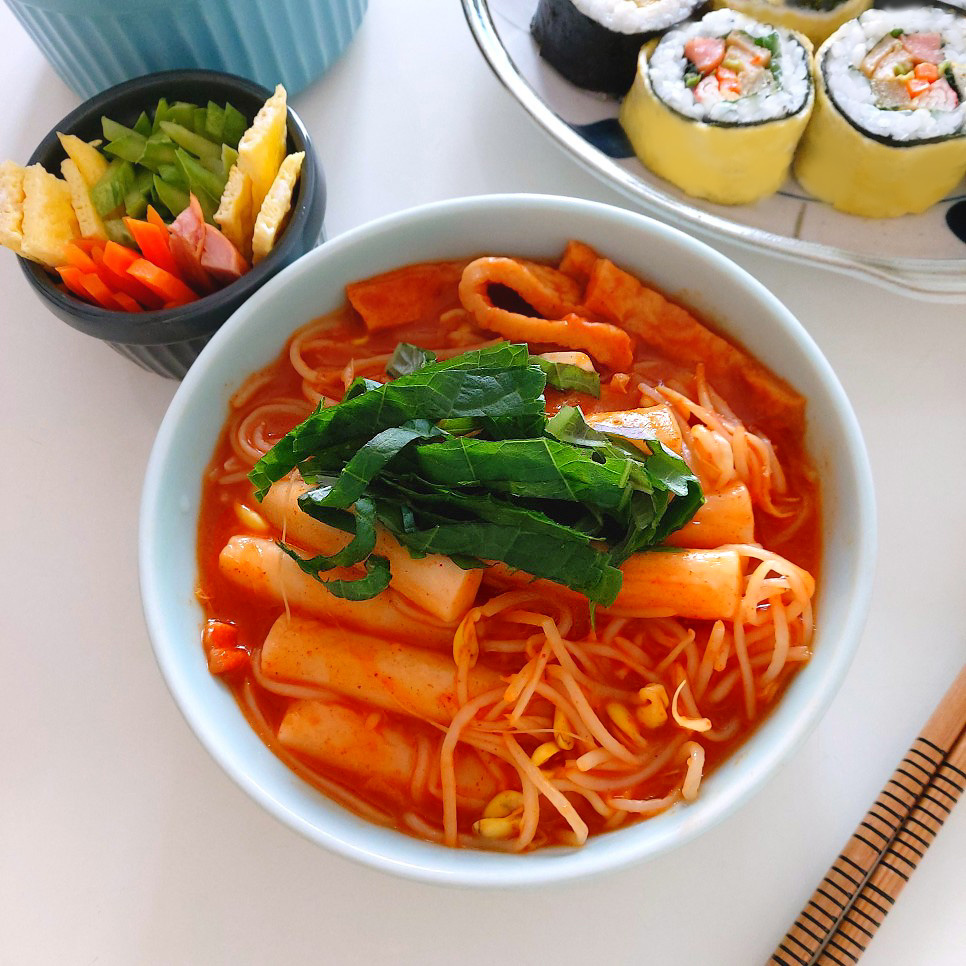Refreshing Soybean Sprout Tteokbokki with Broth
Make Your Broth Tteokbokki Even Fresher! Soybean Sprout Tteokbokki

Tteokbokki is always a good idea, but everyone has their favorite style! I’m a fan of chewy rice cakes (tteok) and the soupy kind of tteokbokki. For side dishes, I love flat dumplings and hard-boiled eggs. When I want my broth tteokbokki to be a bit lighter and more refreshing, I add soybean sprouts and perilla leaves. This dish is the ultimate king of refreshing, savory flavors! You’ll love mixing rice into the leftover broth – it’s absolutely delicious.
Main Ingredients- 15-20 pieces of Tteokbokki rice cakes
- 2 handfuls of fresh soybean sprouts (approx. 100g)
- 2-3 leaves of cabbage
- 4-5 slices of carrot
- 1-2 stalks of green onion
- 2-3 leaves of fresh perilla leaves
- 1 sheet of fish cake
- 1/3 pot of broth or water (approx. 300ml)
- A little bit of zucchini (optional)
Tteokbokki Seasoning- 2 Tbsp Gochujang (Korean chili paste)
- 2 Tbsp Soy Sauce
- 1 Tbsp Gochugaru (Korean chili powder)
- 1 tsp Plum Extract or Sugar
- 2 Tbsp Gochujang (Korean chili paste)
- 2 Tbsp Soy Sauce
- 1 Tbsp Gochugaru (Korean chili powder)
- 1 tsp Plum Extract or Sugar
Cooking Instructions
Step 1
1. Prepare the ingredients. Rinse the soybean sprouts thoroughly under running water and drain them well. Slice the green onions diagonally; if using scallions, chop them finely. Cut the cabbage, carrot, zucchini, and fish cake into thick strips, similar in width to the tteokbokki rice cakes. You can cut them into your preferred shapes. This recipe is great for using up leftover vegetables in your fridge. Cabbage and mushrooms (if added) pair exceptionally well with soybean sprouts, adding a delightful crispness and refreshing taste.

Step 2
2. Prepare the rice cakes. If you have freshly made, soft rice cakes, you can use them immediately. For refrigerated rice cakes, soak them in water for a short while to soften. For frozen rice cakes, blanch them in boiling water for 3-4 minutes until they become soft. This process not only softens them but also removes any unwanted odors, resulting in a much more pleasant texture.

Step 3
3. Start cooking the tteokbokki. Soybean sprouts can be sensitive to temperature changes and may develop an unpleasant odor if not cooked properly. A key tip to prevent this is to maintain a consistent temperature throughout the cooking process. Once the broth or water is boiling, add the soybean sprouts and the prepared vegetables (excluding the perilla leaves) to the bottom of the pot.

Step 4
4. Add the rice cakes and fish cake, then the seasoning. Arrange the blanched tteokbokki rice cakes and fish cake on top of the vegetables. This layering helps prevent the rice cakes and fish cake from sticking to the bottom of the pot. Add all ingredients except the perilla leaves, along with the seasoning mixture, to the pot and bring to a boil over high heat.

Step 5
5. Simmer gently to let the flavors meld. Once you notice the soybean sprouts have lost their raw smell and developed a pleasant, savory aroma, reduce the heat to medium-low. Continue to simmer for a little longer, allowing the sauce to thicken and fully coat the rice cakes. Be careful not to overcook, as the rice cakes can become tough.

Step 6
6. Garnish with perilla leaves and serve. When the rice cakes have absorbed the sauce and the broth has reached your desired consistency, turn off the heat. Transfer the tteokbokki to a serving bowl and generously top with the julienned perilla leaves. For an extra touch of richness, you can drizzle a little sesame oil over the top before serving.




